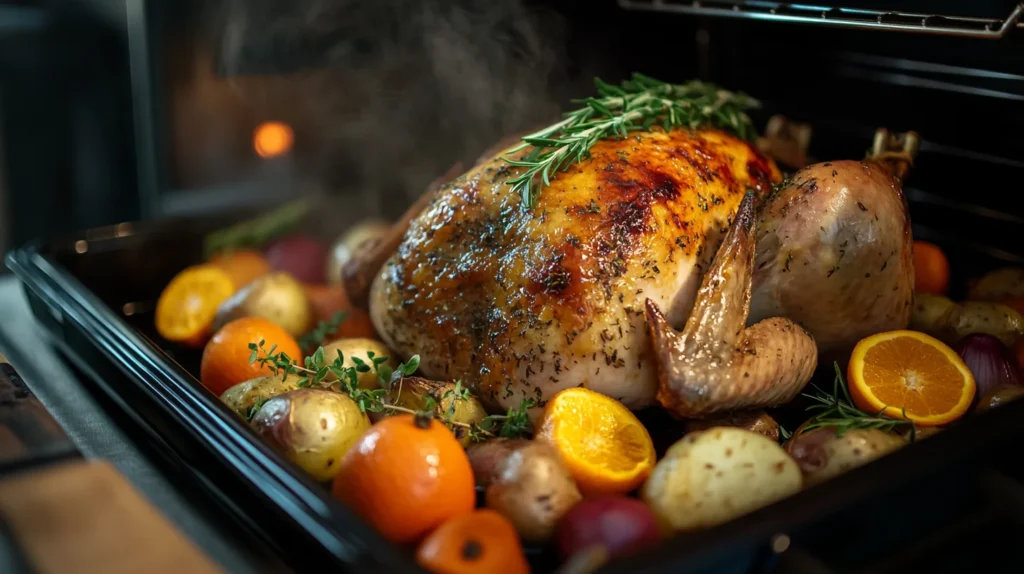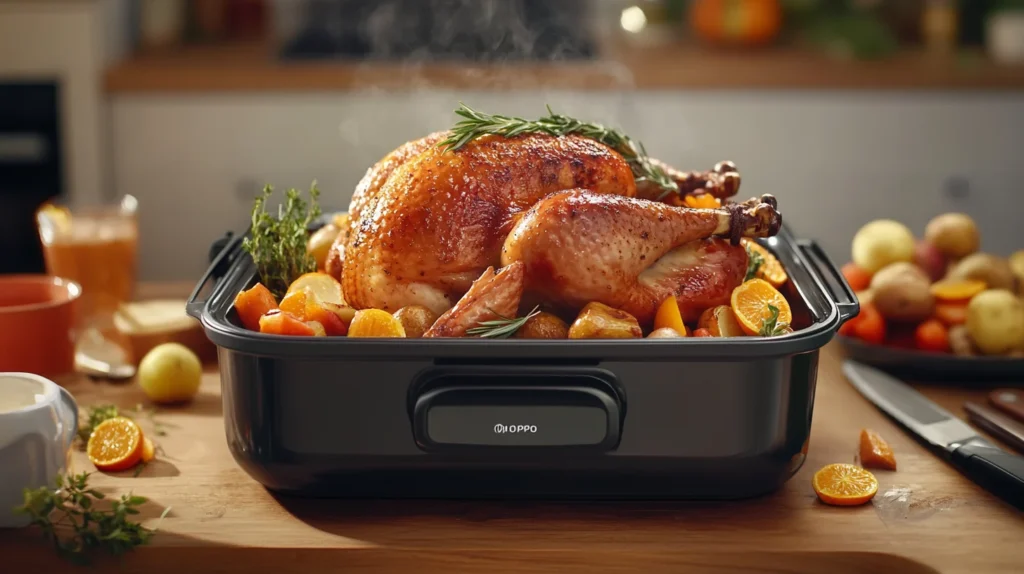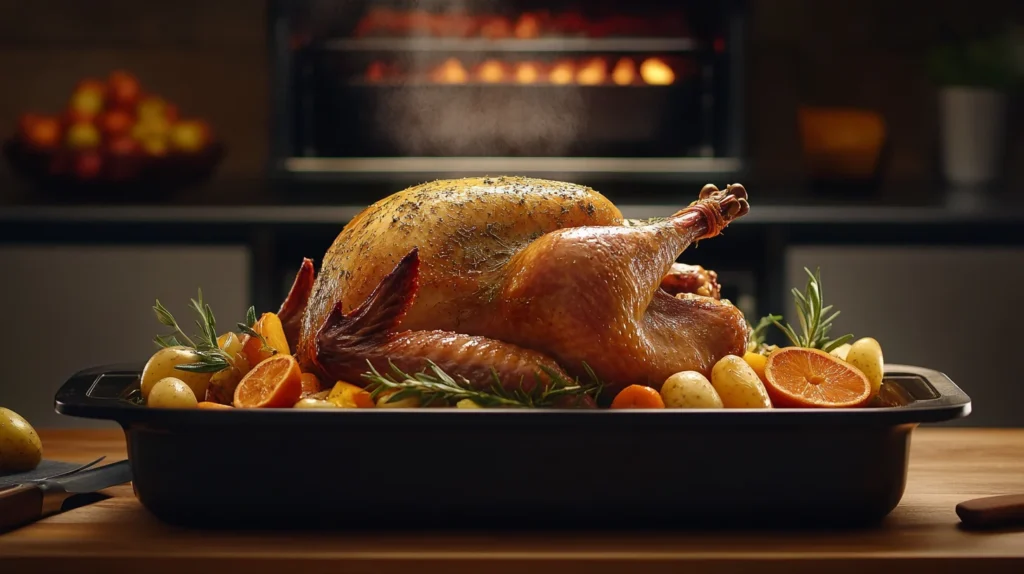Turkey Roaster Oven: Your Ultimate Guide to Best Roasting Turkey
The Turkey Roaster Oven is an essential tool in any kitchen, especially during festive seasons. This versatile appliance not only delivers perfectly cooked turkey but also offers convenience and efficiency that traditional ovens lack. Whether you’re preparing a Thanksgiving feast or hosting a family gathering, a Turkey Roaster Oven can elevate your culinary experience to new heights.
The Ultimate Guide to Turkey Roaster Ovens
In this guide, we will explore every aspect of Turkey Roaster Ovens, from their functions and benefits to choosing the right one for your needs. This comprehensive overview will help you understand how to maximize your cooking experience while ensuring a delicious roast each time.
Understanding Turkey Roaster Ovens
Before diving deeper into the specifics, it’s important to establish a clear understanding of what a Turkey Roaster Oven is and why it has become an indispensable part of cooking, especially for large meals.
What is a Turkey Roaster Oven?
A Turkey Roaster Oven is a specialized kitchen appliance designed primarily for roasting turkey but can also be used for other meats and dishes. Typically larger than conventional ovens, these appliances often feature a spacious interior suitable for whole turkeys, large cuts of meat, and even casseroles.
What sets Turkey Roaster Ovens apart is their unique heating method, which utilizes both direct heat and convection technology. This allows for even cooking and browning, resulting in a juicy turkey with crisp skin. Many models come equipped with adjustable temperature controls and timers, making them user-friendly and convenient for cooks of all skill levels.
How Does a Turkey Roaster Oven Work?
Turkey Roaster Ovens operate by heating elements located at the bottom of the unit, promoting consistent heat distribution throughout the cooking chamber. Most models include a lid that traps moisture, creating a steaming effect that helps retain tenderness in the meat.
Some roasters are outfitted with an internal fan that circulates hot air, enhancing cooking efficiency and reducing cooking times. This means you can achieve perfectly cooked turkey much faster than in a traditional oven. Additionally, many Turkey Roaster Ovens offer various cooking settings, allowing users to select between slow-roasting, baking, and other methods.

Benefits of Using a Turkey Roaster Oven
There are numerous advantages to using a Turkey Roaster Oven, especially when it comes to preparing large meals. One of the most significant benefits is the additional cooking space it provides. During holidays like Thanksgiving, oven real estate is limited, and a dedicated roaster can free up your main oven for side dishes and desserts.
Moreover, these ovens are often energy-efficient, consuming less electricity than traditional ovens. They do not heat up your kitchen as much, offering a more comfortable cooking environment, especially during warm weather.
Lastly, Turkey Roaster Ovens are relatively easy to clean. Many models have removable parts that are dishwasher safe, making post-meal cleanup less of a chore.
Choosing the Right Turkey Roaster Oven
With so many options available on the market, selecting the ideal Turkey Roaster Oven can be overwhelming. However, focusing on key features and your specific cooking needs can make the process easier.
Key Features to Consider
When choosing a Turkey Roaster Oven, several features should be top-of-mind. Start by assessing capacity—a model that fits your typical turkey size is crucial.
Look for units with adjustable temperature controls, as this allows for versatile cooking options beyond turkey roasting. A built-in timer is another beneficial feature that enhances convenience, letting you set it and forget it.
Also, consider ease of use; intuitive controls and a sturdy design are vital for a stress-free cooking experience.
Size and Capacity: Finding the Perfect Fit
Selecting the right size is paramount when investing in a Turkey Roaster Oven. You don’t want to purchase a model that’s too small to accommodate your holiday turkey or too large for everyday use.
If you regularly host gatherings, opt for a roaster with a larger capacity. On the other hand, if your cooking needs are minimal, a smaller model may be more appropriate. Measure the space available in your kitchen before making a purchase to ensure a good fit.
Another consideration is the weight of the unit. Heavier models generally indicate sturdier construction, but they may also require more effort to handle when it comes time to store or clean.
Material and Build Quality
The material and build quality of a Turkey Roaster Oven significantly impact its performance and longevity. Stainless steel is a popular choice due to its durability, resistance to rust, and sleek appearance. It also distributes heat evenly across the cooking surface.
Additionally, look for models with a non-stick interior, which makes for easier cleanup. Plastic components can be lightweight but may not withstand high temperatures as well as metal counterparts; always check for heat resistance ratings.
Brand Recommendations and Reviews
Researching brand reputation can save you from potential pitfalls. Popular brands like Oster, Rival, and Cuisinart have established themselves as reliable makers of Turkey Roaster Ovens. Reading customer reviews can provide valuable insights into performance, durability, and ease of use.
Don’t hesitate to ask friends or family about their experiences with different models. Personal recommendations can often point you toward the best choice for your cooking style and preferences.
Preparing for the Roast
Once you’ve selected the perfect Turkey Roaster Oven, it’s time to prepare for the main event—roasting your turkey. Preparation is just as important as the roasting process itself, and there are several steps to follow.
Selecting the Ideal Turkey
Choosing the right turkey is critical for achieving maximum flavor and tenderness. Fresh or frozen, the decision largely depends on availability and preference. If opting for frozen, remember to allow sufficient time for thawing in the refrigerator—about 24 hours for every four to five pounds.
When shopping, look for organically raised turkeys or those that are free-range for ethical considerations and potentially better flavor. Pay attention to labels; avoid turkeys that contain added hormones or preservatives.
Essential Ingredients and Seasoning Tips
The importance of seasoning cannot be overstated—properly seasoned turkey elevates the dish from ordinary to extraordinary. A simple mixture of salt, pepper, garlic powder, and herbs such as rosemary and thyme works wonders.
Consider brining your turkey beforehand for an extra layer of flavor and moisture. A wet brine involves soaking the turkey in a saltwater solution, while a dry brine requires rubbing salt directly onto the skin. Both methods enhance taste and juiciness, leading to a delightful culinary experience.
Prepping Your Turkey for Roasting
Proper prep work can make a world of difference. Start by removing the giblets and neck from the cavity—these can be saved for gravy if desired. Rinse the turkey under cool water, then pat it dry with paper towels.
Next, season the inside and outside generously. Don’t forget to tuck the wing tips under the body to prevent burning. You can also place aromatics like onion, apple, or citrus fruits inside the cavity for additional flavor during roasting.
Traditionally, adding a bit of butter or oil under the skin creates a crispy and flavorful exterior. Ensuring the turkey is at room temperature before roasting can contribute to even cooking.

Cooking with a Turkey Roaster Oven
Now that you’re fully prepared, it’s time to learn how to cook your turkey in the Turkey Roaster Oven.
Step-by-Step Instructions for Roasting a Turkey
Begin by preheating your Turkey Roaster Oven according to the manufacturer’s instructions. Ensure it reaches the desired temperature before placing the turkey inside.
Position the turkey breast-side up on the rack that usually comes with the unit. If your roaster doesn’t include a rack, placing the turkey directly in the pan will still yield excellent results.
Close the lid securely, and monitor cooking progress periodically. Do not open the lid too often, as this releases valuable heat and extends cooking time.
Cooking Times and Temperature Guidelines
Cooking times will vary depending on the weight of the turkey and the settings of your roaster. Generally, plan for about 13-15 minutes of cooking time per pound at a temperature of 325 degrees Fahrenheit.
Use a meat thermometer to check for doneness—the internal temperature should reach 165 degrees Fahrenheit in the thickest part of the thigh. This ensures that harmful bacteria are eliminated while keeping the meat juicy and tender.
Troubleshooting Common Issues
Even with preparation, issues may arise during roasting. If your turkey seems to be cooking unevenly, rotate it halfway through the cooking process.
If the skin is browning too quickly, loosely cover the turkey with aluminum foil to shield it from direct heat. Conversely, if the turkey appears pale, you might need to increase the cooking temperature slightly for the last half hour to promote browning.
Be vigilant about monitoring the internal temperature to prevent overcooking. If you face difficulties, consult your roaster’s manual for troubleshooting tips tailored to your specific model.
Post-Roasting Care and Serving Suggestions
After your turkey is roasted to perfection, proper care and serving techniques are essential for maintaining its appeal and flavor.
Safely Carving Your Turkey
Allow the turkey to rest for about 20-30 minutes after removing it from the roaster. Resting helps redistribute juices throughout the meat, making it easier to carve.
Using a sharp carving knife, start by removing the legs and thighs first. Slice between the joint to separate them from the body. Next, carve the breast meat, slicing it against the grain for maximum tenderness.
Serve the carved pieces on a platter, garnished with fresh herbs or slices of citrus for an appealing presentation.
Storing Leftovers Properly
Leftover turkey can be a culinary treasure if stored correctly. Allow any remaining turkey to cool before transferring it to airtight containers. Refrigerate within two hours, and consume leftovers within three to four days for safety.
For longer storage, consider freezing portions of turkey. Wrap them tightly in plastic wrap or aluminum foil, then place them in freezer bags. Properly stored, frozen turkey can last up to six months without sacrificing quality.
Creative Recipes for Leftover Turkey
Don’t let leftover turkey go to waste—transform it into delicious new dishes!
One option is to create a comforting turkey soup by simmering the bones with vegetables and herbs for rich broth. Alternatively, shred the turkey for use in sandwiches, tacos, or salads.
You can also make a savory turkey casserole by combining leftover turkey with vegetables and pasta topped with cheese, then baking until bubbly. The possibilities are endless!

Frequently Asked Questions (FAQ)
How Long Does It Take to Cook a Turkey in a Roaster?
The cooking time for a turkey in a turkey roaster oven varies based on its size. Here’s a quick guide:
- 8-12 lbs: 2.5 to 3 hours
- 12-16 lbs: 3 to 3.5 hours
- 16-20 lbs: 3.5 to 4 hours
Always use a meat thermometer to ensure the turkey reaches the recommended internal temperature of 165°F (74°C).
Is It Better to Put Turkey in Oven or Electric Roaster?
An electric roaster often cooks faster and is more energy-efficient, especially if you have a smaller kitchen or are cooking for fewer people. It also keeps the heat contained, meaning you don’t have to worry about heating your whole kitchen. On the other hand, a traditional oven gives you more room and flexibility for a larger turkey or additional sides.
What Size Roaster Oven for a 20 lb Turkey?
FFor a 20 lb turkey, a 22-quart or larger turkey roaster oven is ideal. The size of the roaster is important because it provides enough space for heat to circulate around the bird, ensuring even cooking. If you’re cooking for a larger gathering, opting for a roaster that holds 24 quarts or more is a good idea. This size accommodates bigger turkeys and allows for better airflow, which results in a more evenly roasted bird.
Larger roaster ovens also tend to have more power, ensuring that your turkey cooks efficiently without overcrowding the roaster, which can lead to uneven heat distribution. It’s essential to choose a roaster that suits your turkey’s size to get the best cooking results.
Do You Put Water in the Roaster When Cooking a Turkey?
You can put water or broth in the bottom of the roaster to keep the turkey moist, but it’s not necessary. If you choose to add liquid, make sure it doesn’t touch the turkey directly, as this can prevent the skin from becoming crispy.
Conclusion
In conclusion, a Turkey Roaster Oven is a game-changer in the kitchen, making holiday cooking not just easier but also more enjoyable. With the ability to roast a perfectly cooked turkey with minimal fuss and maximum flavor, it’s no wonder this appliance has become a staple for many home cooks.
By choosing the right model, preparing adequately, and employing smart cooking techniques, anyone can create a stunning centerpiece for their festive meals. Whether you’re a seasoned chef or just starting, embracing the Turkey Roaster Oven can lead to memorable dining experiences filled with joy and satisfaction. Elevate your cooking game today and discover how a Turkey Roaster Oven can transform your holiday feasts!
If you’re in the mood for a decadent dessert, don’t miss out on this irresistible Reese’s Caramel Cheesecake! With its rich caramel topping and creamy cheesecake base, it’s a perfect treat for any occasion. You can find the full recipe and step-by-step instructions here.
Print
Turkey Roaster Oven: Your Ultimate Guide to Best Roasting Turkey
- Total Time: 3.5-4.5 hours
- Yield: 10–12 servings 1x
Description
Using a roaster oven is an excellent way to cook a turkey evenly while freeing up your traditional oven for side dishes. This method results in a tender, golden-brown turkey with minimal effort. Perfect for Thanksgiving, holidays, or family dinners, this recipe ensures a moist and flavorful bird every time.
Ingredients
- 1 whole turkey (12–14 lbs), thawed
- 1/4 cup unsalted butter, melted
- 1/4 cup olive oil
- 2 teaspoons salt
- 1 teaspoon black pepper
- 1 tablespoon garlic powder
- 1 tablespoon onion powder
- 1 teaspoon paprika (for a golden finish)
- 2 sprigs fresh rosemary
- 2 sprigs fresh thyme
- 1 lemon, quartered
- 1 onion, quartered
- 4 garlic cloves, peeled
- 1 cup chicken or turkey broth
Instructions
-
Prepare the Turkey:
- Remove the turkey from its packaging and take out the giblets and neck from the cavity. Pat the turkey dry with paper towels.
-
Season the Turkey:
- In a small bowl, mix the melted butter, olive oil, salt, pepper, garlic powder, onion powder, and paprika. Brush the turkey all over with the mixture, including under the skin if possible, for extra flavor.
-
Stuff the Turkey:
- Stuff the cavity with rosemary, thyme, lemon, onion, and garlic.
-
Preheat the Roaster Oven:
- Preheat your roaster oven to 325°F (165°C). Add 1 cup of chicken or turkey broth to the roaster pan to keep the turkey moist during cooking.
-
Roast the Turkey:
- Place the turkey on the rack inside the roaster oven, breast side up. Cover with the roaster lid and cook for approximately 15 minutes per pound, or until the internal temperature reaches 165°F (74°C) in the thickest part of the breast and 175°F (79°C) in the thigh.
-
Optional Browning:
- If the turkey is not golden brown, baste it with the drippings and increase the heat to 375°F (190°C) for the last 20-30 minutes.
-
Rest and Carve:
- Remove the turkey from the roaster oven and let it rest for 20-30 minutes before carving. This allows the juices to redistribute, resulting in a moist turkey.
Notes
- If using a frozen turkey, ensure it’s fully thawed before cooking. Allow approximately 24 hours of thawing time in the fridge for every 4-5 lbs.
- Add additional broth during cooking if needed to prevent the drippings from burning.
- Use the drippings to make a rich, flavorful gravy.
- Prep Time: 20 minutes
- Cook Time: 3-4 hours (for a 12-14 lb turkey)
- Category: Main Course
- Method: Roasting
- Cuisine: American
Nutrition
- Serving Size: 1 serving (6 oz turkey)
- Calories: 320
- Sugar: 0g
- Sodium: 520mg
- Fat: 18g
- Saturated Fat: 6g
- Unsaturated Fat: 12g
- Trans Fat: 0g
- Carbohydrates: 1g
- Fiber: 0g
- Protein: 36g
- Cholesterol: 110mg

